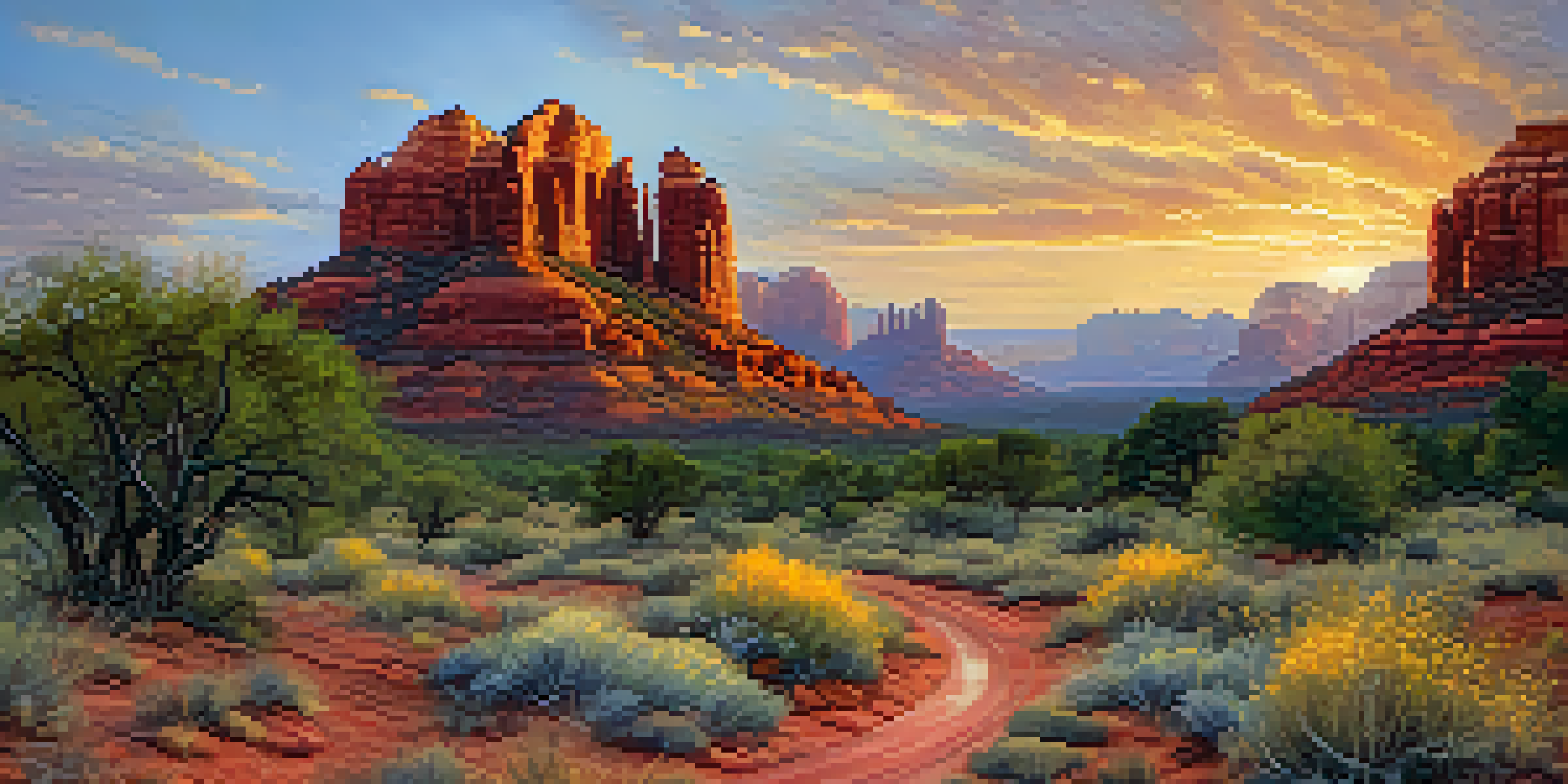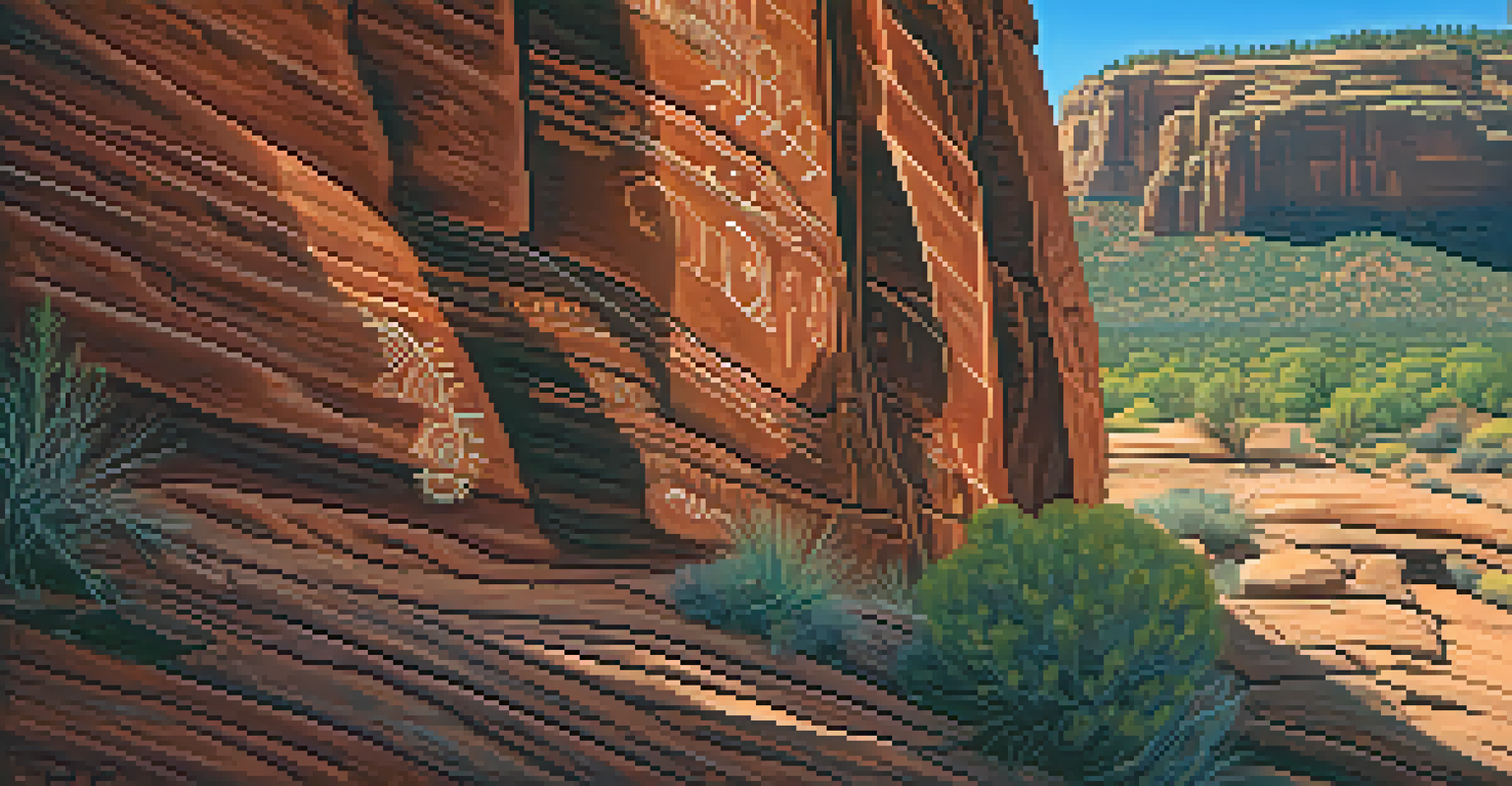The Legacy of Native Americans in Sedona's Trail System

Introduction to Sedona's Rich Native American Heritage
Sedona, Arizona, is not just known for its stunning red rock formations; it’s also steeped in a rich Native American legacy. The area has been home to several Indigenous tribes, including the Yavapai and Apache, who have lived in harmony with the land for centuries. Their connection to the environment is reflected in the trails that weave through this breathtaking landscape, offering more than just scenic views.
The land is the only thing that lasts. The land is what our ancestors walked on, and it is what we will walk on, and what our children will walk on.
As we explore Sedona's trail system, we uncover stories of the past and the cultural significance of these paths. Each trail tells a story of the people who walked them long before modern hikers arrived. This journey not only reveals the beauty of Sedona but also deepens our understanding of the native cultures that shaped it.
Understanding this heritage enriches our experience as we traverse these trails, allowing us to appreciate the history embedded in the very ground beneath our feet. It’s a reminder that these paths are not just for recreation; they are a testament to the enduring legacy of Native American communities.
Trail Systems: Pathways of Ancestors
The trails in Sedona serve as vital pathways that have been used by Native Americans for generations. These routes were once essential for travel, trade, and communication between tribes, highlighting the intricate web of relationships that existed long before European settlers arrived. Many of the trails still in use today have maintained their original routes, connecting hikers with the footsteps of their ancestors.

For example, the Soldier Pass Trail is thought to have been an important route for the area's Indigenous peoples. As you hike this trail, you can almost hear the echoes of history, imagining the gatherings and exchanges that took place among tribes. The significance of these trails goes beyond mere navigation; they symbolize a deep respect for the land and its history.
Sedona's Trails Hold Cultural Significance
The trails in Sedona are steeped in Native American history, serving as pathways that connect modern hikers with the rich legacy of Indigenous tribes.
By walking these ancient paths, hikers can develop a profound appreciation for the cultural landscapes shaped by Native American traditions. It’s a unique opportunity to connect with the past while enjoying the natural beauty that Sedona has to offer.
Cultural Significance of Sedona's Trails
The trails in Sedona are not just physical pathways; they are imbued with cultural meaning and spiritual significance. For many Native American tribes, the land is considered sacred, and the trails serve as a means to connect with their ancestors and the spiritual world. Hiking these trails can provide a sense of reverence and understanding of the beliefs that have been passed down through generations.
We are all connected to the earth. The trails are a reminder of where we came from and the history that shapes our present.
For instance, the Red Rock Crossing is a site where Native Americans have gathered for ceremonies and rituals. As you stand by the flowing waters of Oak Creek with Cathedral Rock in the background, it’s easy to feel the spiritual energy that this place holds. It’s a reminder that nature and spirituality are intertwined in Indigenous cultures.
Engaging with these trails allows visitors to reflect on their own relationship with nature while honoring the traditions of those who came before them. It’s a beautiful blend of reverence and exploration, making each hike a meaningful experience.
Preserving Native American Traditions
Preservation of Native American traditions is crucial not only for cultural identity but also for the stewardship of the land. Many of the trails in Sedona are maintained by local tribes, ensuring that the stories and practices associated with these paths are not lost to time. This collaborative effort fosters a sense of pride and connection among the tribes and the broader community.
Efforts to preserve these traditions include educational programs and cultural events that invite both locals and visitors to learn about the rich history of the Indigenous peoples. By participating in these activities, hikers can gain a deeper understanding of the significance of the land they are exploring. This not only enhances their hiking experience but also promotes respect and appreciation for Native American cultures.
Preservation of Native Traditions
Local tribes actively maintain the trails, ensuring the stories and cultural practices associated with them are passed down through generations.
The ongoing commitment to preserving these traditions serves as a bridge between the past and present, ensuring that future generations can continue to learn from and honor the legacy of Native Americans in Sedona.
Modern-Day Native American Voices in Sedona
Today, Native American voices are integral to the narrative of Sedona's trail system. Many Indigenous individuals actively engage in discussions about land use, conservation, and cultural heritage. Their perspectives are vital in shaping how the trails are viewed and preserved, emphasizing the importance of Indigenous knowledge in environmental stewardship.
Local tribes often collaborate with conservation groups to ensure that the trails remain not only accessible but also respectful of the cultural significance they hold. This partnership highlights the importance of incorporating Indigenous wisdom in managing natural resources, showcasing how traditional practices can inform modern conservation efforts.
By listening to these voices, hikers can gain a broader understanding of the complexities surrounding land use and preservation. It encourages a dialogue that respects the past while looking towards a sustainable future for all who cherish Sedona’s trails.
Exploring Native American Art and Symbols
As you hike through Sedona's trails, keep an eye out for Native American art and symbols that enrich the landscape. Rock art, pottery shards, and other artifacts can often be found along these paths, offering glimpses into the lives of those who walked here long ago. These symbols tell stories of daily life, spirituality, and connection to the land, adding another layer of significance to your hiking experience.
For example, petroglyphs carved into rock surfaces serve as a visual language that speaks to the history and beliefs of Native American cultures. Observing these ancient markings fosters a sense of wonder and curiosity, prompting hikers to reflect on the stories behind them. Each symbol carries meaning and serves as a reminder of the people who once thrived in these lands.
Engaging with Native American Voices
Modern Indigenous perspectives are crucial for understanding land use and conservation, emphasizing the importance of incorporating traditional knowledge into environmental stewardship.
Engaging with these artistic expressions can transform a simple hike into a profound journey of discovery. It encourages a deeper connection to the heritage of the area and inspires respect for the artistry and history that continue to influence Sedona today.
Conclusion: Honoring the Legacy of Native Americans
As we conclude our exploration of Sedona's trail system, it's clear that the legacy of Native Americans is woven into the very fabric of the land. The stories, traditions, and cultural significance of these trails offer a unique perspective that enriches our outdoor experiences. It’s an invitation for all who visit to honor and respect the history that came before them.
By understanding the importance of these trails and the Indigenous peoples who have cared for them, hikers can forge a deeper connection to both the land and its history. It’s a chance to embrace the beauty of Sedona while recognizing the enduring legacy of its first inhabitants.

So, as you set out on your next adventure through Sedona, take a moment to reflect on the stories that these trails hold. Honor the past, cherish the present, and contribute to a future that respects and celebrates the rich heritage of Native Americans in this extraordinary landscape.